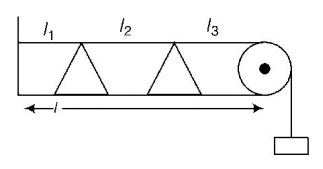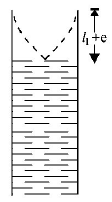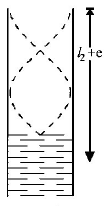131. What is the effect of humidity on sound waves when humidity increases?
A
Speed of sound waves is more
B
Speed of sound waves is less
C
Speed of sound waves remains same
D
Speed of sound waves becomes zero
Answer :
Speed of sound waves is more
132. Three sound waves of equal amplitudes have frequencies $$\left( {v - 1} \right),v,\left( {v + 1} \right).$$ They superpose to give beats. The number of beats produced per second will be :
A
3
B
2
C
1
D
4
Answer :
2
133. In a sinusoidal wave, the time required for a particular point, to move from maximum displacement to zero displacement is $$0.170\,s.$$ The frequency of the wave is
A
$$1.47\,Hz$$
B
$$0.36\,Hz$$
C
$$0.73\,Hz$$
D
$$2.94\,Hz$$
Answer :
$$1.47\,Hz$$
134.
From a wave equation
$$y = 0.5\sin \frac{{2\,\pi }}{{3.2}}\left( {64\,t - x} \right),$$
the frequency of the wave is
A
$$5\,Hz$$
B
$$15\,Hz$$
C
$$20\,Hz$$
D
$$25\,Hz$$
Answer :
$$20\,Hz$$
135. If $${n_1},{n_2}$$ and $${n_3}$$ are the fundamental frequencies of three segments into which a string is divided, then the original fundamental frequency $$n$$ of the string is given by
A
$$\frac{1}{n} = \frac{1}{{{n_1}}} + \frac{1}{{{n_2}}} + \frac{1}{{{n_3}}}$$
B
$$\frac{1}{{\sqrt n }} = \frac{1}{{\sqrt {{n_1}} }} + \frac{1}{{\sqrt {{n_2}} }} + \frac{1}{{\sqrt {{n_3}} }}$$
C
$$\sqrt n = \sqrt {{n_1}} + \sqrt {{n_2}} + \sqrt {{n_3}} $$
D
$$n = {n_1} + {n_2} + {n_3}$$
Answer :
$$\frac{1}{n} = \frac{1}{{{n_1}}} + \frac{1}{{{n_2}}} + \frac{1}{{{n_3}}}$$
136. In a resonance tube with tuning fork of frequency $$512\,Hz,$$ first resonance occurs at water level equal to $$30.3\,cm$$ and second resonance occurs at $$63.7\,cm.$$ The maximum possible error in the speed of sound is
A
$$51.2\,cm/s$$
B
$$102.4\,cm/s$$
C
$$204.8\,cm/s$$
D
$$153.6\,cm/s$$
Answer :
$$204.8\,cm/s$$
137.
The equation of a wave on a string of linear mass density $$0.04\,kg\,{m^{ - 1}}$$ is given by
$$y = 0.02\left( m \right)\sin \left[ {2\pi \left( {\frac{t}{{0.04\left( s \right)}} - \frac{x}{{0.50\left( m \right)}}} \right)} \right]$$
The tension in the string is
A
$$4.0\,N$$
B
$$12.5\,N$$
C
$$0.5\,N$$
D
$$6.25\,N$$
Answer :
$$6.25\,N$$
138. A pipe of length $${\ell _1},$$ closed at one end is kept in a chamber of gas of density $${\rho _1}.$$ A second pipe open at both ends is placed in a second chamber of gas of density $${\rho _2}.$$ The compressibility of both the gases is equal. Calculate the length of the second pipe if frequency of first overtone in both the cases is equal
A
$$\frac{4}{3}{\ell _1}\sqrt {\frac{{{\rho _2}}}{{{\rho _1}}}} $$
B
$$\frac{4}{3}{\ell _1}\sqrt {\frac{{{\rho _1}}}{{{\rho _2}}}} $$
C
$${\ell _1}\sqrt {\frac{{{\rho _2}}}{{{\rho _1}}}} $$
D
$${\ell _1}\sqrt {\frac{{{\rho _1}}}{{{\rho _2}}}} $$
Answer :
$$\frac{4}{3}{\ell _1}\sqrt {\frac{{{\rho _1}}}{{{\rho _2}}}} $$
139. The extension in a string, obeying Hooke’s law, is $$x.$$ The speed of sound in the stretched string is $$v.$$ If the extension in the string is increased to $$1.5x,$$ the speed of sound will be
A
$$1.22\,v$$
B
$$0.61\,v$$
C
$$1.50\,v$$
D
$$0.75\,v$$
Answer :
$$1.22\,v$$
140.
A source of sound $$S$$ emitting waves of frequency $$100\,Hz$$ and an observer $$O$$ are located at some distance from each other. The source is moving with a speed of $$19.4\,m{s^{ - 1}}$$ at an angle of $${60^ \circ }$$ with the source observer line as shown in the figure. The observer is at rest. The apparent frequency observed by the observer is (velocity of sound in air $$330\,m{s^{ - 1}}$$ )

A
$$103\,Hz$$
B
$$106\,Hz$$
C
$$97\,Hz$$
D
$$100\,Hz$$
Answer :
$$103\,Hz$$



